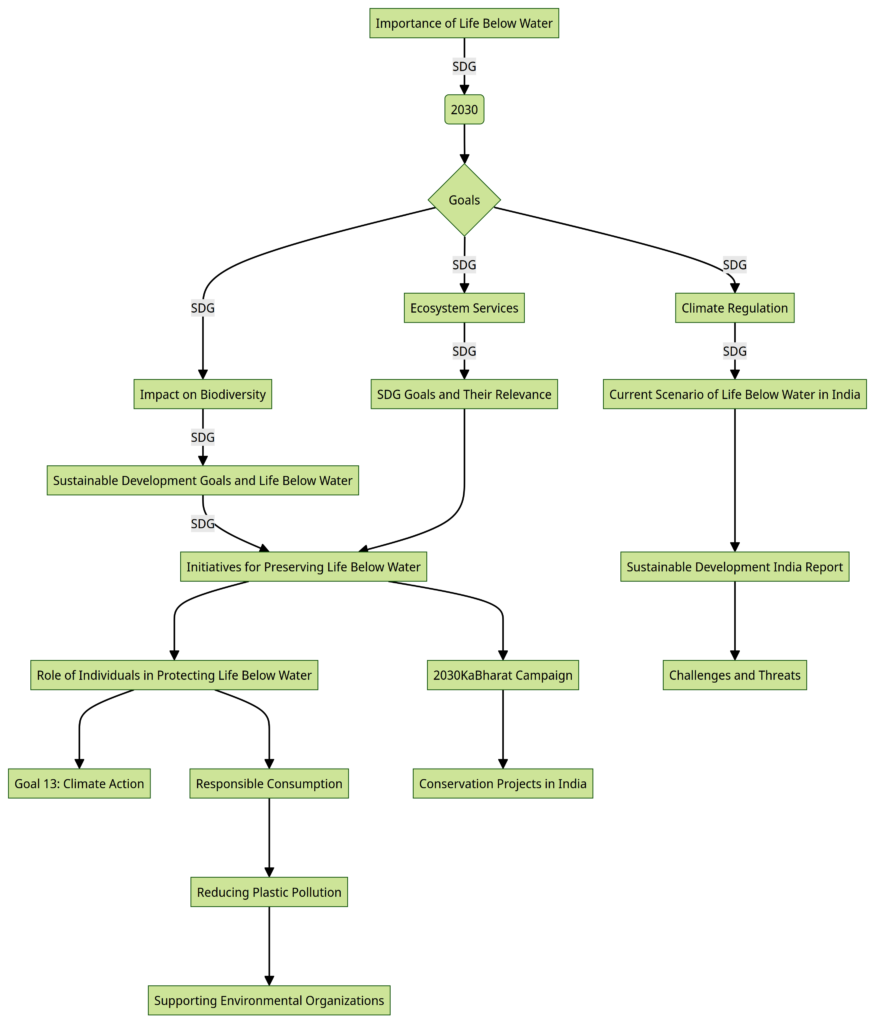Life below water plays a vital role in maintaining the delicate balance of our planet’s ecosystems. From supporting biodiversity to providing essential services, the preservation of marine environments is crucial for a sustainable future. In this article, we will explore the importance of life below water, its connection to the Sustainable Development Goals (SDGs), the current scenario in India, initiatives for its preservation, and the role individuals can play in protecting this invaluable resource.
1. Importance of Life Below Water
Impact on Biodiversity
The oceans and other bodies of water are home to a rich and diverse array of flora and fauna. They provide habitats for countless species, many of which are yet to be discovered. By preserving life below water, we safeguard these biodiversity hotspots and help maintain the web of life that sustains our planet.
Ecosystem Services
Life below water is not just about the creatures that inhabit these environments; it also encompasses the essential services they provide. The oceans, for instance, regulate the planet’s climate by absorbing vast amounts of carbon dioxide. They act as a crucial carbon sink, mitigating the effects of climate change. Moreover, marine ecosystems support local economies through fishing, tourism, and transportation.
Climate Regulation
The interplay between life below water and the Earth’s climate is intricate. Healthy marine ecosystems contribute to climate regulation by producing oxygen through photosynthesis, absorbing carbon dioxide, and influencing weather patterns. Protecting these ecosystems is imperative in the fight against climate change.
2. Sustainable Development Goals (SDGs) and Life Below Water
Sustainable Development Goals (SDGs) are a set of global targets adopted by the United Nations to address various sustainability challenges. One of these goals, Goal 14, specifically focuses on the conservation and sustainable use of marine resources. By achieving this goal, we can ensure the health and vitality of our oceans and protect life below water.
3. SDG Goals and Their Relevance
Goal 14: Life Below Water
Goal 14 aims to conserve and sustainably use the oceans, seas, and marine resources for sustainable development. It emphasizes the need to prevent and reduce marine pollution, protect coastal ecosystems, regulate fishing practices, and conserve marine biodiversity. Achieving Goal 14 is crucial for the well-being of both marine life and human communities that depend on the ocean.
Goal 6: Clean Water and Sanitation
While not explicitly focused on marine environments, Goal 6 addresses the importance of water and sanitation for all. Preserving involves ensuring clean water sources, reducing pollution, and protecting freshwater ecosystems that are intricately connected to the health of marine ecosystems.
Goal 13: Climate Action
Goal 13 emphasizes the need for urgent action to combat climate change and its impacts. As mentioned earlier, life below water plays a significant role in climate regulation. By protecting marine habitats and reducing carbon emissions, we contribute to the fight against climate change and its detrimental effects on both land and sea.

4. Current Scenario of in India
India is a country with a diverse range of marine ecosystems, from the Arabian Sea to the Bay of Bengal. However, the current scenario of life below water in India presents numerous challenges. According to the Sustainable Development India Report, pollution, overfishing, habitat destruction, and climate change are among the significant threats facing marine ecosystems in the country.
5. Initiatives for Preserving Life Below Water
Addressing the challenges faced by life below water in India requires collective action and initiatives. One such initiative is the 2030KaBharat campaign, which promotes sustainable development across various sectors, including marine conservation. This campaign raises awareness about the importance of life below water and encourages individuals, communities, and organizations to take action.
Additionally, various conservation projects are underway in India to protect marine ecosystems. These projects focus on restoring coral reefs, establishing marine protected areas, regulating fishing practices, and reducing pollution. Through these efforts, the preservation of life below water is being prioritized.
6. Role of Individuals in Protecting Life Below Water
While governments and organizations play a crucial role in marine conservation, individuals can also contribute to protecting in several ways. By practicing responsible consumption, reducing the use of single-use plastics, and making sustainable choices, we can minimize our impact on marine ecosystems. Supporting environmental organizations and participating in local cleanup initiatives are other effective ways to protect life below water.
Life below water matters deeply to the overall health and sustainability of our planet. By understanding its importance, supporting the Sustainable Development Goals, addressing the current challenges in India, and taking individual action, we can ensure the preservation of marine ecosystems for future generations. Let us embrace our responsibility to protect and contribute to a better and more sustainable world.
FAQs
1. How does life below water affect climate regulation?
2. What are the major threats to marine ecosystems in India?
3. How does Goal 14 contribute to sustainable development?
4. What role do individuals play in preserving life below water? 5. What initiatives are being undertaken to protect marine
